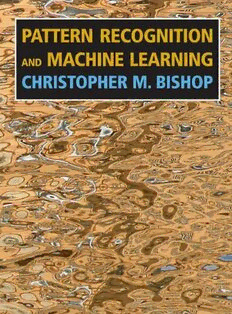Table Of ContentInformation Science and Statistics
Series Editors:
M. Jordan
J. Kleinberg
B. Scho¨lkopf
Information Science and Statistics
Akaike and Kitagawa: The Practice of Time Series Analysis.
Bishop: Pattern Recognition and Machine Learning.
Cowell, Dawid, Lauritzen, and Spiegelhalter: Probabilistic Networks and
Expert Systems.
Doucet, de Freitas, and Gordon: Sequential Monte Carlo Methods in Practice.
Fine: Feedforward Neural Network Methodology.
Hawkins and Olwell: Cumulative Sum Charts and Charting for Quality Improvement.
Jensen:Bayesian Networks and Decision Graphs.
Marchette: Computer Intrusion Detection and Network Monitoring:
A Statistical Viewpoint.
Rubinstein and Kroese: The Cross-Entropy Method: A Unified Approach to
Combinatorial Optimization, Monte Carlo Simulation, and Machine Learning.
Studený: Probabilistic Conditional Independence Structures.
Vapnik: The Nature of Statistical Learning Theory, Second Edition.
Wallace: Statistical and Inductive Inference by Minimum Massage Length.
Christopher M. Bishop
Pattern Recognition and
Machine Learning
ChristopherM.BishopF.R.Eng.
AssistantDirector
MicrosoftResearchLtd
CambridgeCB30FB,U.K.
[email protected]
http://research.microsoft.com/(cid:1)cmbishop
SeriesEditors
MichaelJordan ProfessorJonKleinberg BernhardScho¨lkopf
DepartmentofComputer DepartmentofComputer MaxPlanckInstitutefor
ScienceandDepartment Science BiologicalCybernetics
ofStatistics CornellUniversity Spemannstrasse38
UniversityofCalifornia, Ithaca,NY14853 72076Tu¨bingen
Berkeley USA Germany
Berkeley,CA94720
USA
LibraryofCongressControlNumber:2006922522
ISBN-10:0-387-31073-8
ISBN-13:978-0387-31073-2
Printedonacid-freepaper.
©2006SpringerScience+BusinessMedia,LLC
Allrightsreserved.Thisworkmaynotbetranslatedorcopiedinwholeorinpartwithoutthewrittenpermissionofthepublisher
(SpringerScience+BusinessMedia,LLC,233SpringStreet,NewYork,NY10013,USA),exceptforbriefexcerptsinconnection
withreviewsorscholarlyanalysis.Useinconnectionwithanyformofinformationstorageandretrieval,electronicadaptation,
computersoftware,orbysimilarordissimilarmethodologynowknownorhereafterdevelopedisforbidden.
Theuseinthispublicationoftradenames,trademarks,servicemarks,andsimilarterms,eveniftheyarenotidentifiedassuch,
isnottobetakenasanexpressionofopinionastowhetherornottheyaresubjecttoproprietaryrights.
PrintedinSingapore. (KYO)
9 8 7 6 5 4 3 2 1
springer.com
Thisbookisdedicatedtomyfamily:
Jenna,Mark,andHugh
Totaleclipseofthesun,Antalya,Turkey,29March2006.
Preface
Pattern recognition has its origins in engineering, whereas machine learning grew
out of computer science. However, these activities can be viewed as two facets of
the same field, and together they have undergone substantial development over the
pasttenyears. Inparticular,Bayesianmethodshavegrownfromaspecialistnicheto
becomemainstream, whilegraphicalmodelshaveemergedasageneralframework
fordescribingandapplyingprobabilisticmodels. Also,thepracticalapplicabilityof
Bayesianmethodshasbeengreatlyenhancedthroughthedevelopmentofarangeof
approximateinferencealgorithmssuchasvariationalBayesandexpectationpropa-
gation. Similarly,newmodelsbasedonkernelshavehadsignificantimpactonboth
algorithmsandapplications.
Thisnewtextbookreflectstheserecentdevelopmentswhileprovidingacompre-
hensive introduction to the fields of pattern recognition and machine learning. It is
aimedatadvancedundergraduatesorfirstyearPhDstudents,aswellasresearchers
andpractitioners,andassumesnopreviousknowledgeofpatternrecognitionorma-
chinelearningconcepts. Knowledgeofmultivariatecalculusandbasiclinearalgebra
isrequired,andsomefamiliaritywithprobabilitieswouldbehelpfulthoughnotes-
sentialasthebookincludesaself-containedintroductiontobasicprobabilitytheory.
Becausethisbookhasbroadscope,itisimpossibletoprovideacompletelistof
references,andinparticularnoattempthasbeenmadetoprovideaccuratehistorical
attribution of ideas. Instead, the aim has been to give references that offer greater
detailthanispossiblehereandthathopefullyprovideentrypointsintowhat,insome
cases,isaveryextensiveliterature. Forthisreason,thereferencesareoftentomore
recenttextbooksandreviewarticlesratherthantooriginalsources.
The book is supported by a great deal of additional material, including lecture
slides as well as the complete set of figures used in the book, and the reader is
encouragedtovisitthebookwebsiteforthelatestinformation:
http://research.microsoft.com/∼cmbishop/PRML
vii
viii PREFACE
Exercises
The exercises that appear at the end of every chapter form an important com-
ponent of the book. Each exercise has been carefully chosen to reinforce concepts
explainedinthetextortodevelopandgeneralizetheminsignificantways,andeach
is graded according to difficulty ranging from ((cid:1)), which denotes a simple exercise
taking a few minutes to complete, through to ((cid:1)(cid:1)(cid:1)), which denotes a significantly
morecomplexexercise.
It has been difficult to know to what extent these solutions should be made
widely available. Those engaged in self study will find worked solutions very ben-
eficial, whereas many course tutors request that solutions be available only via the
publisher so that the exercises may be used in class. In order to try to meet these
conflictingrequirements,thoseexercisesthathelpamplifykeypointsinthetext,or
thatfillinimportantdetails,havesolutionsthatareavailableasaPDFfilefromthe
book web site. Such exercises are denoted by www. Solutions for the remaining
exercises are available to course tutors by contacting the publisher (contact details
are given on the book web site). Readers are strongly encouraged to work through
theexercisesunaided,andtoturntothesolutionsonlyasrequired.
Although this book focuses on concepts and principles, in a taught course the
students should ideally have the opportunity to experiment with some of the key
algorithms using appropriate data sets. A companion volume (Bishop and Nabney,
2008) will deal with practical aspects of pattern recognition and machine learning,
and will be accompanied by Matlab software implementing most of the algorithms
discussedinthisbook.
Acknowledgements
First of all I would like to express my sincere thanks to Markus Svense´n who
has provided immense help with preparation of figures and with the typesetting of
thebookinLATEX. Hisassistancehasbeeninvaluable.
IamverygratefultoMicrosoftResearchforprovidingahighlystimulatingre-
searchenvironmentandforgivingmethefreedomtowritethisbook(theviewsand
opinions expressed in this book, however, are my own and are therefore not neces-
sarilythesameasthoseofMicrosoftoritsaffiliates).
Springer has provided excellent support throughout the final stages of prepara-
tionofthisbook,andIwouldliketothankmycommissioningeditorJohnKimmel
forhissupportandprofessionalism,aswellasJosephPilieroforhishelpindesign-
ingthecoverandthetextformatandMaryAnnBricknerforhernumerouscontribu-
tionsduringtheproductionphase. Theinspirationforthecoverdesigncamefroma
discussionwithAntonioCriminisi.
I also wish to thank Oxford University Press for permission to reproduce ex-
cerpts from an earlier textbook, Neural Networks for Pattern Recognition (Bishop,
1995a). The images of the Mark 1 perceptron and of Frank Rosenblatt are repro-
ducedwiththepermissionofArvinCalspanAdvancedTechnologyCenter. Iwould
also like to thank Asela Gunawardana for plotting the spectrogram in Figure 13.1,
and Bernhard Scho¨lkopf for permission to use his kernel PCA code to plot Fig-
ure12.17.
PREFACE ix
Many people have helped by proofreading draft material and providing com-
mentsandsuggestions,includingShivaniAgarwal,Ce´dricArchambeau,ArikAzran,
Andrew Blake, Hakan Cevikalp, Michael Fourman, Brendan Frey, Zoubin Ghahra-
mani, Thore Graepel, Katherine Heller, Ralf Herbrich, Geoffrey Hinton, Adam Jo-
hansen, Matthew Johnson, Michael Jordan, Eva Kalyvianaki, Anitha Kannan, Julia
Lasserre,DavidLiu,TomMinka,IanNabney,TonatiuhPena,YuanQi,SamRoweis,
BalajiSanjiya,TobySharp,AnaCostaeSilva,DavidSpiegelhalter,JayStokes,Tara
Symeonides,MartinSzummer,MarshallTappen,IlkayUlusoy,ChrisWilliams,John
Winn,andAndrewZisserman.
Finally, I would like to thank my wife Jenna who has been hugely supportive
throughouttheseveralyearsithastakentowritethisbook.
ChrisBishop
Cambridge
February2006
Mathematical notation
I have tried to keep the mathematical content of the book to the minimum neces-
sarytoachieveaproperunderstandingofthefield. However,thisminimumlevelis
nonzero, and it should be emphasized that a good grasp of calculus, linear algebra,
andprobabilitytheoryisessentialforaclearunderstandingofmodernpatternrecog-
nition and machine learning techniques. Nevertheless, the emphasis in this book is
onconveyingtheunderlyingconceptsratherthanonmathematicalrigour.
I havetried touseaconsistent notationthroughout thebook, although attimes
this means departing from some of the conventions used in the corresponding re-
search literature. Vectors are denoted by lower case bold Roman letters such as
x, and all vectors are assumed to be column vectors. A superscript T denotes the
transpose of a matrix or vector, so that xT will be a row vector. Uppercase bold
roman letters, such as M, denote matrices. The notation (w1,...,wM) denotes a
row vector with M elements, while the corresponding column vector is written as
w =(w1,...,wM)T.
The notation [a,b] is used to denote the closed interval from a to b, that is the
intervalincludingthevaluesaandbthemselves,while(a,b)denotesthecorrespond-
ingopeninterval, thatistheintervalexcludingaandb. Similarly, [a,b)denotesan
interval that includes a but excludes b. For the most part, however, there will be
littleneedtodwellonsuchrefinementsaswhethertheendpointsofanintervalare
includedornot.
The M × M identity matrix (also known as the unit matrix) is denoted IM,
whichwillbeabbreviatedtoIwherethereisnoambiguityaboutitdimensionality.
IthaselementsIij thatequal1ifi=j and0ifi(cid:2)=j.
A functional is denoted f[y] where y(x) is some function. The concept of a
functionalisdiscussedinAppendixD.
Thenotationg(x) =O (f(x))denotesthat|f(x)/g(x)|isboundedasx → ∞.
Forinstanceifg(x)=3x2+2,theng(x)=O (x2).
Theexpectationofafunctionf(x,y)withrespecttoarandomvariablexisde-
notedbyEx[f(x,y)]. Insituationswherethereisnoambiguityastowhichvariable
is being averaged over, this will be simplified by omitting the suffix, for instance
xi

